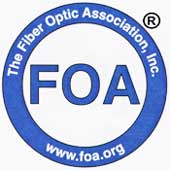
There is so much technical material on the FOA Online Reference Guide it can be overwhelming. If you are looking for a specific topic, we suggest you use our web site's Table of Contents and the site search (above) which will search the FOA website, FOA Online Reference Guide, FOA Newsletter, etc. to find relevant materials.

Since it began in 1995, the FOA has been developing an extensive knowledge base for fiber optics. Until we began, most information on fiber optics was in the form of academic textbooks, not appropriate for installers and contractors, and application notes from manufacturers on their specific products. The FOA focus was on the practical side of fiber optics, the design, installation and operation of fiber optic communications networks.
By tapping the knowledge of dozens of technical experts worldwide who were working in the field and training other fiber techs, the FOA has created an extensive knowledge base on fiber optics and premises cabling. FOA has published this material online and printed in textbooks.
With the advent of YouTube, we created a channel and began uploading instructional videos, now over 100 total, including more than 50 short lectures on fiber optic topics.
This knowledge base also allowed FOA to create Fiber U online training which now includes many free online self study courses.
And the FOA network of worldwide experts has also worked to create fiber optic curriculum resources which are made available at no cost to appropriate organizations.
The FOA knowledge base is widely used. About 1/2 million users download 4 million pages from the FOA guide every year. The FOA YouTube videos have been viewed 3 million times. And the FOA textbooks are used to train fiber optic techs around the world - even in Spanish and French.
The FOA knowledge base includes suggested materials in helping individuals to become prepared for FOA certification exams. The information provided is not intended to be inclusive of all potentially useful resources, nor does inclusion in this knowledge base constitute an endorsement by the FOA.
There are several ways the FOA makes its knowledge base available to reach all interested users. Here's more details on each of them.
The FOA Online Reference Guide To Fiber Optics and Premises Cabling has been created as a free service to the fiber optics and communications industries, as well as any other field that uses fiber optics. It encompasses almost a thousand pages of technical information, online and video tutorials and tech bulletins covering every aspect of fiber optics and premises cabling. Everyone can use this as a reference source for fiber optics and premises cabling. Students at FOA-Approved Schools can use this as a reference textbook for FOA certifications and those already certified can use it for a reference on the technologies or practices.
The goal of this guide is to provide an extensive, reliable, non-commercial source of information on fiber optics and premises cabling (copper, fiber and wireless) for educating students, network users, designers, installers, contractors, etc. In creating the materials, we considered the needs of many readers and attempted to provide for their special needs.
The organization of this material is chosen to make it appropriate for teaching fiber optic technology, manufacture, installation, design, testing and other related topics and to provide a reference for the FOA certification exams. As a reference, the Table of Contents will allow anyone to find topics of interest. The Table of Contents is the master link to the material and is linked on every page.
The format of all this material is simplified to allow fast loading with any browser and use on most mobile devices like this smart phone or tablet.
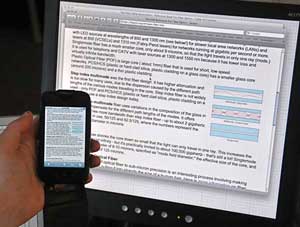
The FOA Online Reference Guide also includes two famous guides for beginners:
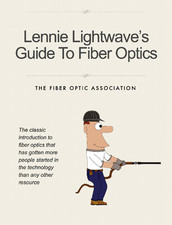
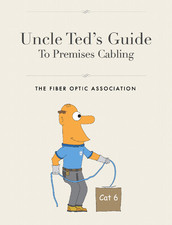
Remember, as an online reference, this material is expanded and updated regularly to reflect changes in technologies and applications. It's always going to be incomplete, since we're always finding new things to add to it. It you have suggestions on how to improve it, contact us at info@thefoa.org.
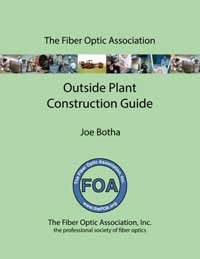 FOA Reference Guide to OSP Fiber Optics book" width="" height="" />
FOA Reference Guide to OSP Fiber Optics book" width="" height="" />
Fiber Optics - Premises Cabling - Outside Plant - OSP Construction - Network Design - Fiber Optic Testing
Another benefit of the FOA knowledge base is we can publish our own textbooks for those who prefer printed books or eBooks on their tablet or Kindle. There are FOA textbooks covering basic fiber optics, outside plant fiber optics, premises cabling (copper, fiber and wireless), OSP construction, fiber optic network design and fiber optic testing. The basic textbook is also available in Spanish and French. The design book is available in Spanish.
Click on each book image for more information about the book. Go here for information on all books.

The advent of YouTube offered a unique opportunity for FOA to share its know;edge base with others via video. The FOA has created a special FOA channel on YouTube, thefoainc, where we're posting video lectures on more than 50 topics and instructional videos for everyone's use. We have videos on fiber optic cable preparation and, for those working on premises cabling, termination of UTP cable. Watch for lots more!
A complete listing of FOA YouTube Videos is on the Guide's Table of Contents
Fiber U offers free online self-study training and tutorials based on the materials from the FOA Guide. There are more than a dozen subjects, most are also preparation for FOA certifications. You can get certificates of completion for most subjects.
FOA uses its knowledge base and network of advisors to provide assistance to educators and trainers in developing their teaching abilities and the educational resources for use in their classes. FOA and its advisors have extensive experience in traditional educational environments, online training and blended learning. Using the FOA knowledge base and resources, they can select from materials appropriate for their programs. All this assistance is provided at no cost as part of the original charter of the FOA.
FOA offers free teaching kits for STEM (science, technology, engineering and math) teachers in k-12 grades featuring plastic optical fiber that visually demonstrates how fiber optics transmits information as pulses of light and provides a basis for additional experiments and science projects by students. Read more.
For technical high school and college classes, FOA has modules for teaching fiber and cabling as part of science, engineering, IT and telecom courses that explain to students how these topics use fiber optics and cabling as communications media.
For adult education as well as technical high schools and colleges, we have comprehensive resources available that include classroom materials and hands-on lab manuals appropriate for classes leading to FOA certifications.These resources extend from the basics of the media to complex issues related to construction, installation, testing, operation and restoration of networks.
Contact FOA for more details about how its resources can be used in development of appropriate training programs.
The FOA will generally grant permission on request have the material used for reference, education, etc. on a non-commercial basis as long as the source (FOA) is identified with attribution and no claims are made that FOA endorses the user, their products or services. FOA does not allow the commercial use of its copyrighted material to promote any company or organization.
The material has been produced and reviewed by a many contributors whom we wish to thank for their work in contributing, creating and reviewing the materials included here: Jim Hayes, Editor, Contributors: Elias Awad, Bob Ballard, Joe Botha, Craig Bowden, Duane Clayton, Tom Collins, Doug Elliott, Ian Gordon Fudge, Jorge Garcia, Bill Graham, Arnie Harris, Karen Hayes, John Highhouse, Ron Leger, Eric Loytty, Terry O'Malley, Eric Pearson, Dan Silver, Jim Underwood, Chuck Vella and many, many more.
Note: This information is provided by The Fiber Optic Association, Inc. as a benefit to those interested in designing, manufacturing, selling, installing or using fiber optic communications systems or networks. It is intended to be used as a overview and/or basic guidelines and in no way should be considered to be complete or comprehensive. These guidelines are strictly the opinion of the FOA and the reader is expected to use them as a basis for learning, reference and creating their own documentation, project specifications, etc. The FOA assumes no liability for their use.
Interested in linking to FOA webpages or reproducing FOA technical materials? Here is the FOA policy on use of our technical materials .
| Contact The FOA (C)2008-2021, The Fiber Optic Association, Inc. |